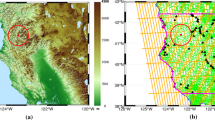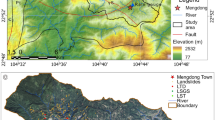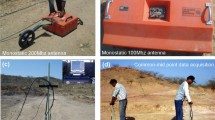Abstract
In order to achieve a rapid and accurate identification of soil stratification information and accelerate the development of smart agriculture, this paper conducted soil stratification experiments on agricultural soils in the Mollisols area of Northeast China using Ground Penetrating Radar (GPR) and obtained different types of soil with frequencies of 500 MHz, 250 MHz, and 100 MHz antennas. The soil profile data were obtained for 500 MHz, 250 MHz, and 100 MHz antennas, and the dielectric properties of each type of soil were analyzed. In the image processing procedure, wavelet analysis was first used to decompose the pre-processed radar signal and reconstruct the high-frequency information to obtain the reconstructed signal containing the stratification information. Secondly, the reconstructed signal is taken as an envelope to enhance the stratification information. The Hilbert transform is applied to the envelope signal to find the time-domain variation of the instantaneous frequency and determine the time-domain location of the stratification. Finally, the dielectric constant of each soil horizon is used to obtain the propagation velocity of the electromagnetic wave at the corresponding position to obtain the stratification position of each soil horizon. The research results show that the 500 MHz radar antenna can accurately delineate Ap/Ah, horizon and the absolute accuracy of the stratification is within 5 cm. The effect on the soil stratification below the tillage horizon is not apparent, and the absolute accuracy of the 250 MHz and 100 MHz radar antennas on the stratification is within 9 cm. The overwhelming majority of the overall calculation errors are kept to within 15%. Based on the three central frequency antennas, the soil horizon detection rate reaches 93.3%, which can achieve accurate stratification of soil profiles within 1 m. The experimental and image processing methods used are practical and feasible; however, the GPR will show a missed detection for soil horizons with only slight differences in dielectric properties. Overall, this study can quickly and accurately determine the information of each soil stratification, ultimately providing technical support for acquiring soil configuration information and developing smart agriculture.
Similar content being viewed by others
References
Chen H, Zhang W C, Gao H R et al., 2018. Climate change and anthropogenic impacts on wetland and agriculture in the Songnen and Sanjiang Plain, Northeast China. Remote Sensing, 10(3): 356. https://doi.org/10.3390/rs10030356
Collins M E, Doolittle J A, 1987. Using ground-penetrating radar to study soil microvariability. Soil Science Society of America Journal, 51(2): 491–493. doi: 10.2136/sssaj1987.03615995005100020045x
Daniels D J, 1996. Surface-penetrating radar. Electronics & Communication Engineering Journal, 8(4): 165–182. https://doi.org/10.1049/ecej:19960402
de Mendonça B A F, Filho E I F, Schaefer C E G R et al., 2014. Use of geophysical methods for the study of sandy soils under Campinarana at the National Park of Viruá, Roraima State, Brazilian Amazonia. Journal of Soils and Sediments, 14(3): 525–537. https://doi.org/10.1007/s11368-013-0811-2
Du Yuxia, Ming Feng, Zhao Shuping et al., 2022. Investigation on the influence of temperature on soil dielectric constant. Journal of Glaciology and Geocryology, 44(2): 634–642. (in Chinese)
Emmet-Booth J P, Forristal P D, Fenton O et al., 2019. Visual soil evaluation: spade vs. profile methods and the information conveyed for soil management. Soil & Tillage Research, 187: 135–143. https://doi.org/10.1016/j.still.2018.12.002
Furon A C, Wagner-Riddle C, Smith C R et al., 2008. Wavelet analysis of wintertime and spring thaw CO2 and N2O fluxes from agricultural fields. Agricultural and Forest Meteorology, 148(8–9): 1305–1317. https://doi.org/10.1016/j.agrformet.2008.03.006
Guo A T, Ye H C, Li G Q et al., 2023. Evaluation of Hybrid Models for Maize Chlorophyll Retrieval Using Medium- and High-Spatial-Resolution Satellite Images. Rermote Sensing, 15(7): 1784. doi: https://doi.org/10.3390/rs15071784
Han X L, Liu J T, Zhang J et al., 2016. Identifying soil structure along headwater hillslopes using ground penetrating radar based technique. Journal of Mountain Science, 13(3): 405–115. https://doi.org/10.1007/s11629-014-3279-7
He W C, Hao T, Ke H N et al., 2019. VMD analysis of RF-tagged buried pipes for GPR applications. Proceedings of the 2019 IEEE Asia-Pacific Microwave Conference. Singapore: IEEE, 560–562.
Jafarov E E, Parsekian A D, Schaefer K et al., 2017. Estimating active layer thickness and volumetric water content from ground penetrating radar measurements in Barrow, Alaska. Geoscience Data Journal, 4(2): 72–79. https://doi.org/10.1002/gdj3.49
Jevrejeva S, Moore J C, Grinsted A, 2003. Influence of the Arctic Oscillation and El Niño-Southern Oscillation (ENSO) on ice conditions in the Baltic Sea: the wavelet approach. Journal of Geophysical Research:Atmospheres, 108(D21): 4677. https://doi.org/10.1029/2003JD003417
Johnson R W, Glaccum R, Wojtasinski R, 1980. Application of ground penetrating radar to soil survey. Soil and Crop Science Society of Florida Proceedings, 39: 68–72.
Jol H M, 2009. Ground Penetrating Radar: Theory and Applications. Amsterdam: Elsevier, 177–509. https://doi.org/10.1016/B978-0-444-53348-7.X0001-4
Knight R, 2001. Ground penetrating radar for environmental applications. Annual Review of Earth and Planetary Sciences, 29(1): 229–255. https://doi.org/10.1146/annurev.earth.29.1.229
Lebron I, Robinson D A, Goldberg S et al., 2004. The dielectric permittivity of calcite and arid zone soils with carbonate minerals. Soil Science Society of America Journal, 68(5): 1549–1559. https://doi.org/10.2136/sssaj2004.1549
Li Li, Fu Xue, Cui Jia et al., 2020. Soil layer identification based on envelope detector and STFT spectrum analysis of ground penetrating radar signals. Journal of Geo-Information Science, 22(2): 316–327. (in Chinese)
Li X P, Chang S X, Salifu K F, 2014. Soil texture and layering effects on water and salt dynamics in the presence of a water table: a review. Environmental Reviews, 22(1): 41–50. https://doi.org/10.1139/er-2013-0035
Liu C, Liu G, Li H R et al., 2021. Using ground-penetrating radar to investigate the thickness of mollic epipedons developed from loessial parent material. Soil & Tillage Research, 212: 105047. https://doi.org/10.1016/j.still.2021.105047
Liu C, Liu G, Dan C X et al., 2023. Variability in mollic epipedon thickness in response to soil erosion—deposition rates along slopes in Northeast China. Soil and Tillage Research, 227: 105616. https://doi.org/10.1016/j.still.2022.105616
Liu D, Feng J P, Li H et al., 2019. Spatiotemporal Variation Analysis of Regional Flood Disaster Resilience Capability Using an Improved Projection Pursuit Model Based on the Wind-Driven Optimization Algorithm. Journal of Cleaner Production, 241(December): 118406. https://doi.org/10.1016/j.jclepro.2019.118406
Moorman B J, Robinson S D, Burgess M M, 2003. Imaging periglacial conditions with ground-penetrating radar. Permafrost and Periglacial Processes, 14(4): 319–329. https://doi.org/10.1002/ppp.463
Morse M S, Lu N, Godt J W et al., 2012. Comparison of soil thickness in a zero-order basin in the Oregon coast range using a soil probe and electrical resistivity tomography. Journal of Geotechnical and Geoenvironmental Engineering, 138(12): 1470–1482. https://doi.org/10.1061/(ASCE)GT.1943-5606.0000717
Pan Jinmei, Zhang Lixin, Wu Haoran et al., 2012. Effect of soil organic substance on soil dielectric constant. Journal of Remote Sensing, 16(1): 1–24. (in Chinese)
Santos-Francés F, Martínez-Graña A, Ávila-Zarza C et al., 2019. Comparison of methods for evaluating soil quality of semiarid ecosystem and evaluation of the effects of physico-chemical properties and factor soil erodibility (Northern Plateau, Spain). Geoderma, 354: 113872. https://doi.org/10.1016/j.geoderma.2019.07.030
Song Wen, Zhang Min, Wu Kening et al., 2018. Test on nondestructive detection of farmland solum structure in fluvoaquic soil area using ground penetrating radar. Transactions of the Chinese Society of Agricultural Engineering, 34(16): 129–138. (in Chinese)
Topp G C, Davis J L, Annan A P, 1980. Electromagnetic determination of soil water content: measurements in coaxial transmission lines. Water Resources Research, 16(3): 574–582. https://doi.org/10.1029/WR016i003p00574
Van Dam R L, Schlager W, 2002. Identifying causes of ground-penetrating radar reflections using time-domain reflectometry and sedimentological analyses. Sedimentology, 47(2): 435–449. https://doi.org/10.1046/j.1365-3091.2000.00304.x
Winkelbauer J, Völkel J, Leopold M et al., 2011. Methods of surveying the thickness of humous horizons using ground penetrating radar (GPR): an example from the Garmisch-Partenkirchen area of the Northern Alps. European Journal of Forest Research, 130(5): 799–812. https://doi.org/10.1007/s10342-010-0472-2
Yu Xiuxiu, Ma Xingwang, Di Lixiati et al., 2011. Using ground penetrating radar in determination of soil depth. Acta Pedologica Sinica, 48(4): 874–878. (in Chinese)
Zajícová K, Chuman T, 2022. O and A soil horizons boundaries detection using GPR under variable soil moisture conditions. Geoderma, 422: 115934. https://doi.org/10.1016/j.geoderma.0022.115934
Zhang J, Lin H, Doolittle J, 2014. Soil layering and preferential flow impacts on seasonal changes of GPR signals in two contrasting soils. Geoderma, 213: 560–569. https://doi.org/10.1016/j.geoderma.2013.08.035
Zhang S, Liu G, Chen S L et al., 2021. Assessing soil thickness in a black soil watershed in Northeast China using random forest and field observations. International Soil and Water Conservation Research, 9(1): 49–57. https://doi.org/10.1016/j.iswcr.2020.09.004
Zhang Y H, Yang H R, Cui H J et al., 2020. Comparison of the ability of ARIMA, WNN and SVM models for drought forecasting in the Sanjiang Plain, China. Natural Resources Research, 29(2): 1447–64. https://doi.org/10.1007/s11053-019-09512-6
Zhang B, Song X, Zhang Y et al., 2012. Hydrochemical Characteristics and Water Quality Assessment of Surface Water and Groundwater in Songnen Plain, Northeast China. Water Research, 46(8): 2737–48. https://doi.org/10.1016/j.watres.2012.02.033
Author information
Authors and Affiliations
Corresponding author
Additional information
Foundation item: Under the auspices of the National Key R&D Program of China (No. 2021YFD1500100), the Strategic Priority Research Program of the Chinese Academy of Sciences (No. XDA28100000)
Rights and permissions
About this article
Cite this article
Ruan, W., Liu, B., Liu, H. et al. Ground Penetrating Radar (GPR) Identification Method for Agricultural Soil Stratification in a Typical Mollisols Area of Northeast China. Chin. Geogr. Sci. 33, 664–678 (2023). https://doi.org/10.1007/s11769-023-1358-9
Received:
Accepted:
Published:
Issue Date:
DOI: https://doi.org/10.1007/s11769-023-1358-9




